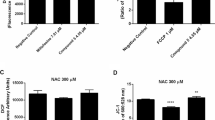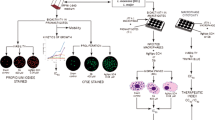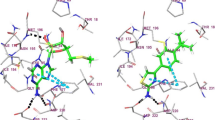Abstract
A new series of silver compounds could be of interest on designing new drugs for the treatment of leishmaniasis. The compounds [Ag(phen)(imzt)]NO3(1), [Ag(phen)(imzt)]CF3SO3(2), [Ag(phen)2](BF4)·H2O (3), [Ag2(imzt)6](NO3)2(4), and imzt have been synthesized and evaluated in vitro for antileishmanial activity against Leishmania. (L.) amazonensis (La) and L. (L.) chagasi (Lc), and two of them were selected for in vivo studies. In addition to investigating the action on Leishmania, their effects on the hydrogen peroxide production and cysteine protease inhibition have also been investigated. As for antileishmanial activity, compound (4) was the most potent against promastigote and amastigote forms of La (IC50 = 4.67 and 1.88 μM, respectively) and Lc (IC50 = 9.35 and 8.05 μM, respectively); and comparable to that of amphotericin B, reference drug. Beside showing excellent activity, it also showed a low toxicity. In the in vivo context, compound (4) reduced the number of amastigotes in the liver and spleen when compared to the untreated group. In evaluating the effect of the compounds on Leishmania, the level of hydrogen peroxide production was maintained between the lag and log phases; however, in the treatment with compound (4) it was possible to observe a reduction of 25.44 and 49.13%, respectively, in the hydrogen peroxide rates when compared to the lag and log phases. It was noticed that the presence of a nitrate ion and imzt in compound (4) was important for the modulation of the antileishmanial activity. Thus, this compound can represent a potentially new drug for the treatment of leishmaniasis.
Graphical abstract




Similar content being viewed by others
References
Vijayakumar S, Pradeep DAS (2018) Recent progress in drug targets and inhibitors towards combting leishmaniasis. Acta Trop 181:95–104
World Health Organization (2016) Leishmaniasis, Geneva, p 375. http://who.int/mediacentre/factsheets/fs375/en/. Accessed Dec 2018
Akhoundi M, Downing T, Votýpka J, Kuhls K, Luke SJ, Cannet A, Ravel C, Marty P, Delaunay P, Kasbari M, Granouillac B, Gradoni L, Sereno D (2017) Leishmania infections: molecular targets and diagnosis. Mol Asp Med 57:1–29
Ghorbani M, Farhoudi R (2018) Leishmaniasis in humans: drug or vaccine therapy? Drug Des Dev Ther 12:25–40
World Health Organization (2018) WHO, Leishmaniasis. Geneva. http://who.int/leishmaniasis/clinical_forms_leishmaniases/en/index2.html. Accessed Dec 2018
Martínez DY, Verdonck K, Kaye PM, Adaui V, Polman K, Llanos-Cuentas A et al (2018) Tegumentary leishmaniasis and coinfections other than HIV. PLoS Negl Trop Dis 12(3):e0006125
Awasthi A, Mathur RK, Saha B (2004) Immune response to Leishmania infection. Indian J Med Res 119:238–258
Codonho BS et al (2016) HSP70 of Leishmania amazonensis alters resistance to different stresses and mitochondrial bioenergetics. Memórias do Instituto Oswaldo Cruz Rio de Janeiro 111(7):460–468
Savoia D (2015) Recent updates and perspectives on leishmaniasis. J Infect Dev Ctries 9(6):588–596
Oliveira LF, Schubach AO, Martins MM, Passos SL, Oliveira RV, Marzochi MC et al (2011) Systematic review of the adverse effects of cutaneous leishmaniasis treatment in the New World. Acta Trop 118(2):87–96
Gontijo VS, Espuri PF, Alves RB, Camargos LF, Santos FV, Judice WAS, Marques MJ, Freitas RP (2015) Leishmanicidal, antiproteolytic, and mutagenic evaluation of alkyltriazoles and alkylphosphocholines. Eur J Med Chem 101:24–33
Castro RAO, Silva-Barcellos NM, Licio CSA, Souza JB, Souza-Testasicca MC, Ferreira FM, Batista MA, Silveira-Lemos D, Moura SL, Frezard F, Rezende SA (2014) Association of liposome-encapsulated trivalent antimonial with ascorbic acid: an effective and safe strategy in the treatment of experimental visceral Leishmaniasis. PLoS One 9(8):104055
Shahverdi AR, Fakhimi A, Shahverdi HR, Minaian S (2007) Synthesis and effect of silver nanoparticles on the antibacterial activity of different antibiotics against Staphylococcus aureus and Escherichia coli. Nanomedicine. 3(2):168–171
Sarkar B, Kumar M, Verma S, Rathore RM (2015) Effect of dietary nanosilver on gut proteases and general performance in Zebrafish (Danio rerio). Int J Aquat Biol 3(2):60–67
Beck I, Hotowy A, Sawosz E, Grodzik M, Wierzbicki M, Kutwin M, Jaworski S, Chwalibog A (2015) Effect of silver nanoparticles and hydroxyproline, administered in ovo, on the development of blood vessels and cartilage collagen structure in chicken embryos. Arch Anim Nutr 69:57–68
Samuel U, Guggenbichler JP (2004) Prevention of catheter-rel the potential of a new nano silver impregnated catheter. Int J Antimicrob Agents 23S1:S75–S78
Asharani P, Sethu S, Lim HK, Balaji G, Valiyaveettil S, Hande MP (2012) Differential regulation of intracellular factors mediating cell cycle, DNA repair and inflammation following exposure to silver nanoparticles in human cells. Genome Integr 3(1):2–14
Yang EJ, Kim S, Kim JS, Choi IH (2018) Inflammasome formation and IL-1β release by human blood monocytes in response to silver nanoparticles. Biomaterials 33(28):6858–6867
Kumar N, Krishnani KK, Gupta SK, Singh NP (2018) Effects of silver nanoparticles on stress biomarkers of Channa striatus: immuno-protective or toxic? Environ Sci Pollut Res Int 25(15):14813–14826
Medici S, Peana M, Crisponi G, Nurchi VM, Lachowicz JI, Remelli M et al (2016) Silver coordination compounds: a new horizon in medicine. Coord Chem Rev 327–328:349–359
Mccann M, Geraghty M, Devereux M, O’shea D, Mason J, O’sullivan L (2000) Insights into the mode of action of the anti-candida activity of 1,10-phenanthroline and its metal chelates. Metal Based Drugs 7(4):185–193
Navarro M, Cisneros-Fajardo EJ, Marchan C (2006) New silver polypyridyl complexes: synthesis, characterization and biologic activity on Leishmania mexicana. Arzneimittelforschung 56:600–604
Segura DF, Netto AVG, Frem RCG, Mauro AE, Da Silva PB, Fernandes JA, Almeida Paz FA, Dias ALT, Silva NC, De Almeida ET, Marques MJ, De Almeida L, Alves KF, Pavan FR, De Souza PC, De Barros HB, Leite CQF (2014) Synthesis and biological evaluation of ternary silver compounds bearingN,N-chelating ligands and thiourea: X-ray structure of [{Ag(bpy)(μ-tu)}2](NO3)2 (bpy=2,2′-bipyridine; tu=thiourea). Polyhedron 79:197–206
Cesarini S, Spallarossa A, Ranise A, Schenone S, Rosano C, la Colla P, Sanna G, Busonera B, Loddo R (2009) N-Acylated and N, N′-diacylated imidazolidine-2-thione derivatives and N, N′-diacylated tetrahydropyrimidine-2(1H)-thione analogues: synthesis and antiproliferative activity. Eur J Med Chem 44:1106–1118
Bowmaker GA, Chaichit N, Pakawatchai C, Skelton BW, AH A (2009) White, Structural and spectroscopic studies of some adducts of silver(I) salts with ethylenethiourea. Can J Chem 87:161–170
Peloso EF, Gonçalves CC, Silva TM, Ribeiro LH, Piñeyro MD, Robello C, Gadelha FR (2012) Tryparedoxin peroxidases and superoxide dismutases expression as well as ROS release are related to Trypanosoma cruzi epimastigotes growth phases. Arch Biochem Biophys 15(520–2):117–122
Arrais-Silva WW, Colhone MC, Ayres DC, Souto PCS, Giorgio S (2005) Effects of hyperbaric oxygen on Leishmania amazonensis promastigotes and amastigotes. Parasitol Int 54(1):1–7
Mosmann T (1983) Rapid colorimetric assay for cellular growth and survival: application to proliferation and cytotoxic assays. J Immunol Methods 65:55–63
Colombo FA, Reis RA, Nunes JB, Dias DF, Dos Santos MH et al (2017) In vivo evaluation of leishmanicidal activity of benzophenone derivatives by qPCR. Med Chem (Los Angeles) 7:890–893
Colombo FA, Pereira-Chioccola VL, Da Silva Meira C, Motoie G, Gava R et al (2015) Performance of a real time PCR for leishmaniasis diagnosis using a L. (L.) infantum hypothetical protein as target in canine samples. Exp Parasitol 157:156–162
Colombo FA et al (2011) Detection of Leishmania (Leishmania) infantum RNA in fleas and ticks collected from naturally infected dogs. Parasitol Res 109(2):267–274
Gutiérrez-Rebolledo GA, Siordia-Reyes AG, Meckes-Fischer M, Jiménez-Arellanes A (2016) Hepatoprotective properties of oleanolic and ursolic acids in antitubercular drug-induced liver damage. Asian Pac J Trop Med 9(7):644–651
Geary WJ (1970) The use of conductivity measurements in organic solvents for the characterisation of coordination compounds. Coord Chem Rev 7:81–122
De Moura TR, Cavalcanti SL, Godoy PRDV, Hojo ETS, Rocha FV, De Almeida ET, Deflon VM, Mauro AE, Netto AVG (2017) Synthesis, characterization and antitumor activity of palladium(II) complexes of imidazolidine-2-thione. Transit Met Chem 42:565–574
Bezerra LJ et al (2006) Avaliação da atividade leishmanicida in vitro de plantas medicinais. Revista Brasileira de Farmacognosia 16:631–637
Escobar P et al (2002) Sensitivities of Leishmania species to hexadecylphosphocholine (miltefosine), ET-18-OCH3 (edelfosine) and amphotericin B. Acta Trop 81:151–157
Morais-Teixeira E, Carvalho AS, Costa JCS, Duarte SL, Mendonça JS, Boechat N, Rabello A (2008) In vitro and in vivo activity of meglumine antimoniate produced at Farmanguinhos-Fiocruz, Brazil, against Leishmania (Leishmania) amazonensis, L (L.) chagasi and L (Viannia) braziliensis. Mem Inst Oswaldo Cruz 103:358–362
De Carvalho GSG, Machado PA, De Paula DTS, Coimbra ES, Da Silva AD (2010) Synthesis, cytotoxicity, and antileishmanial activity of N, N′-disubstituted ethylenediamine and imidazolidine derivatives. Sci World J 10:1723–1730. https://doi.org/10.1100/tsw.2010.176
Barak E, Amin-Spector S, Gerliak E, Goyard S, Holland N, Zilberstein D (2005) Differentiation of Leishmania donovani in host-free system: analysis of signal perception and response. Mol Biochem Parasitol 141:99–108
Mottram JC, Coombs GH (1985) Leishmania mexicana: enzyme activities of amastigotes and promastigotes and their inhibition by antimonials and arsenicals. Exp Parasitol 59:151–160
Mondal S, Roy JJ, Berat T (2014) Characterization of mitochondrial bioenergetic functions between two forms of Leishmania donovani—a comparative analysis. J Bioenerg Biomembr 46(5):395–402
Lahav T, Sivam D, Volpin H, Ronen M, Tsigankov P, Green A, Holland N, Kuzyk M, Borchers C, Zilberstein D, Myler PJ (2011) Multiple levels of gene regulation mediate differentiation of the intracellular pathogen Leishmania. FASEB J 25:515–525
Kima PE (2007) The amastigote forms of Leishmania are experts at exploiting host cell processes to establish infection and persist. Int J Parasitol 37(10):1087–1096
Robledo S, Osorio E, Munõz D, Jaramillo LM, Restrepo A, Arango G, Vélez I (2005) In vitro and in vivo cytotoxicities and antileishmanial activities of thymol and hemisynthetic derivatives. Antimicrob Agents Chemother 49(4):1652–1655
Pires CM, Rodrigues SD, Bristot D, Gaeta HH, Toyama DO, Farias WRL, Toyama MH (2013) Evaluation of macroalgae sulfated polysaccharides on the Leishmania (L.) amazonensis promastigote. Mar Drugs 11:934–943
Gelvez APC, Farias LH, Pereira VS et al (2018) Biosynthesis, characterization and leishmanicidal activity of a biocomposite containing AgNPs-PVP-glucantime. Nanomedicine (Lond) 13(4):373–390
Ovais M, Khalil T, Raza A et al (2016) Green synthesis of silver nanoparticles via plant extracts: beginning a new era in cancer theranostics. Nanomedicine 11(23):3157–3177
Mendonça DVC et al (2018) Comparing the therapeutic efficacy of different amphotericin B-carrying delivery systems against visceral leishmaniasis. Exp Parasitol 186:24–35
Andrade JM et al (2016) Silver and nitrate oppositely modulate antimony susceptibility through aquaglyceroporin in Leishmania (Viannia) species. Antimicrob Agents Chemother 60:4482–4489
Franco LP, Cicillini SA, Biazzotto JC, Schiavon A, Mikhailovsky A, Burks P, Garcia J, Ford PC, Da Silva RS (2014) Photoreactivity of a quantum dot-ruthenium nitrosyl conjugate. J Phys Chem A 118:12184–12191
Ning ZH, Long S, Zhou YY, Peng ZY, Sun YN et al (2015) Effect of exposure routes on the relationships of lethal toxicity to rats from oral, intravenous, intraperitoneal and intramuscular routes. Regul Toxicol Pharmacol 73:613–619
Berczyński P, Duchnik E, Kruk I, Piechowska T, Aboul-Enein HY, Bozdağ-Dündar O, Ceylan-Unlusoy M (2014) 6-Methyl 3-chromonyl 2,4-thiazolidinedione/2,4-imidazolidinedione/2-thioxo-imidazolidine-4-one compounds: novel scavengers of reactive oxygen species. Luminescence 29(4):367–373
Weng Z, Shao X, Graf D, Wang C, Klein C, Wang J, Zhou G-C (2016) Identification of the fused bicyclic derivatives of pyrrolidine and imidazolidinone as dengue virus-2 NS2B-NS3 protease inhibitors. Eur J Med Chem 125:751–759. https://doi.org/10.1016/j.ejmech.2016.09.063
Coombs GH, Mottram JC (1997) Parasite proteinases and amino acid metabolism: possibilities for chemotherapeutic exploitation. Parasitology 114(Suppl):S61–S80
Aparicio IM, Scharfstein J, Lima AP (2004) A new cruzipain-mediated pathway of human cell invasion by Trypanosoma cruzi requires trypomastigote membranes. Infect Immun 72:5892–5902
Duchen MR (2000) Mitochondria and calcium: from cell signaling to cell death. J Physiolol 529:57–68
Vercesi AE, Kowaltowski AJ, Oliveira HC, Castilho RF (2006) Mitochondrial Ca2+ transport, permeability transition and oxidative stress in cell death: implications in cardiotoxicity, neurodegeneration and dyslipidemias. Front Biosci 11:2554–2564
Machado N, Gomes D, Vieira L, Nascimento M, Mittra B, Andrews N (2018) A new source of reactive oxygen species in Leishmania amazonensis: characterization of a heme-activated NADPH oxidase-like. Free Radic Biol Med 128(Supplement 1):S55
Wilkinson SR, Temperton NJ, Mondragon A, Kelly JM (2000) Distinct mitochondrial and cytosolic enzymes mediate trypanothione-dependent peroxide metabolism in Trypanosoma cruzi. J Biol Chem 275(11):8220–8225
Piacenza L, Peluffo G, Alvarez MN, Kelly JM, Wilkinson SR, Radi R (2008) Peroxiredoxins play a major role in protecting Trypanosoma cruzi against macrophage- and endogenously-derived peroxynitrite. Biochem J 410(2):359–368
Piacenza L, Zago MP, Peluffo G, Alvarez MN, Basombrio MA, Radi R (2009) Enzymes of the antioxidant network as novel determiners of Trypanosoma cruzi virulence. Int J Parasitol 39(13):1455–1464
Finzi JK, Chiavegatto CW, Corat KF, Lopez JA, Cabrera OG, Mielniczki-Pereira AA, Colli W, Alves MJ, Gadelha FR (2004) Trypanosoma cruzi response to the oxidative stress generated by hydrogen peroxide. Mol Biochem Parasitol 133(1):37–43
Wiese AG, Pacifici RE, Davies KJ (1995) Transient adaptation of oxidative stress in mammalian cells. Ach Biochem Biophys 318:231–240
Davies JMS, Lowry CV, Davies KJA (1995) Transient adaptation to oxidative stress in yeast. Arch Biochem Biophys 317:1–6
Sena LA, Chandel NS (2012) Physiological roles of mitochondrial reactive oxygen species. Mol Cell 48:158–167
Reczek CR, Chandel NS (2015) ROS-dependent signal transduction. Curr Opin Cell Biol 33:8–13
Schieber M, Chandel NS (2014) ROS function in redox signaling and oxidative stress. Curr Biol 24:R453–R462
Lennicke C, Rahn J, Lichtenfels R, Wessjohann LA, Seliger B (2015) Hydrogen peroxide–production, fate and role in redox signaling of tumor cells. Cell Commun Signal 13:39
Lee S, Tak E, Lee J, Rashid MA, Murphy MP, Ha J, Kim SS (2011) Mitochondrial H2O2 generated from electron transport chain complex I stimulates muscle differentiation. Cell Res 21:817–834
Acknowledgements
This work was sponsored by Grants from CNPq (proc. 487092/2012-0, INCT-INOFAR), FAPESP (2016/17711-5), CAPES and FAPEMIG.
Author information
Authors and Affiliations
Corresponding authors
Additional information
Publisher's Note
Springer Nature remains neutral with regard to jurisdictional claims in published maps and institutional affiliations.
Electronic supplementary material
Below is the link to the electronic supplementary material.
Rights and permissions
About this article
Cite this article
Espuri, P.F., dos Reis, L.L., de Figueiredo Peloso, E. et al. Synthesis and evaluation of the antileishmanial activity of silver compounds containing imidazolidine-2-thione. J Biol Inorg Chem 24, 419–432 (2019). https://doi.org/10.1007/s00775-019-01657-2
Received:
Accepted:
Published:
Issue Date:
DOI: https://doi.org/10.1007/s00775-019-01657-2




